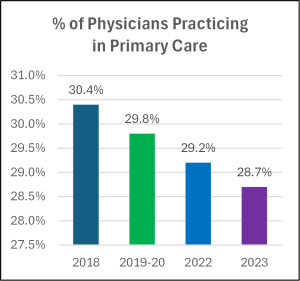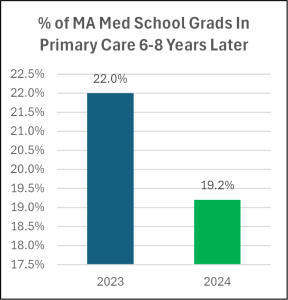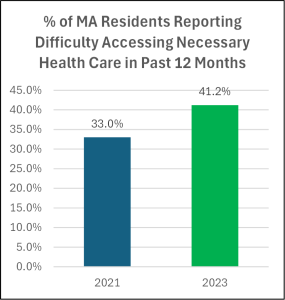The Primary Care Dashboard Paints a Troubling Picture for Massachusetts Healthcare
By Barbra G. Rabson
(June 2025)
“We’re beyond a crisis.”
That is how State Senator Cindy Friedman chose to characterize the current state of primary care in the Commonwealth in her opening remarks to Massachusetts’ newly established Primary Care Access, Delivery, and Payment Task Force in April.
The updated data in the Primary Care Dashboard released last week by the Center for Health Information and Analysis (CHIA) in collaboration with MHQP, support Senator Friedman’s assertion. The Dashboard allows us to see the interplay between and patterns across finance, capacity, performance and equity measures, resulting in a deep, comprehensive view of the failing health of primary care in our state. Here are the key data:
 Spending on primary care continues to decline. As a percentage of total medical spending, primary care spending fell for commercial health plans from an already-low 6.9% in 2022 to 6.7% in 2023.
Spending on primary care continues to decline. As a percentage of total medical spending, primary care spending fell for commercial health plans from an already-low 6.9% in 2022 to 6.7% in 2023.
 The percentage of physicians who practice in primary care continues to trend downward, decreasing steadily from 30.4% in 2018 to 29.8% in 2019/20 to 29.2% in 2022 to 28.7% in 2023.
The percentage of physicians who practice in primary care continues to trend downward, decreasing steadily from 30.4% in 2018 to 29.8% in 2019/20 to 29.2% in 2022 to 28.7% in 2023.
 The percentage of Massachusetts medical and osteopathic graduates practicing primary care after 6 to 8 years declined from 22.0% in 2023 to 19.2% in 2024.
The percentage of Massachusetts medical and osteopathic graduates practicing primary care after 6 to 8 years declined from 22.0% in 2023 to 19.2% in 2024.
 Patients are finding it increasingly difficult to access care. The percentage of residents who reported difficulty obtaining necessary healthcare in the past 12 months increased from 33.0% in 2021 to 41.2% in 2023.
Patients are finding it increasingly difficult to access care. The percentage of residents who reported difficulty obtaining necessary healthcare in the past 12 months increased from 33.0% in 2021 to 41.2% in 2023.
Massachusetts cannot afford to allow these trends to continue. A high-functioning primary care system lays the foundation for high-quality health care. Patients with ready access to quality primary care services can focus on preventative care, effectively manage chronic diseases, and avoid unnecessary and expensive emergency department visits. When the primary care system is failing, overall population health declines, patients suffer with poorer outcomes, and our already unaffordable health care costs skyrocket.
This week, the Massachusetts Division of Insurance will be reviewing proposed health insurance premium rate increases of over 13% for small businesses and individuals. That is unsustainable. Primary care is one of the few areas in our health care system that can simultaneously improve outcomes and drive down costs. The Dashboard provides a clear view of a primary care system in steady decline, with deteriorating investment, access, equity and capacity. Given that, why would policy makers, payers, health systems, and patients not urgently seek to increase investment in primary care?
Since its initial launch in 2023, the Dashboard has generated important public discourse about our deteriorating primary care system, and interest in primary care in Massachusetts has continued to grow, prompting broader attention and policy focus. Now, we have finally reached an inflection point in our policy engagement around primary care in Massachusetts. Governor Healey has called for greater investment in primary care, and new state legislation has established the aforementioned Primary Care Task Force, a committee on which I am honored to serve. This Task Force will provide an important platform for action and critical momentum. But we need to capitalize on this moment to take the necessary steps to support primary care in our state.
In Massachusetts, we pride ourselves on our healthcare leadership, yet we are letting our primary care system fail. Barbara Starfield’s groundbreaking research demonstrated that we need well-organized primary care systems if we want to enable people to live longer, healthier, more equitable lives. It’s time for us to put that leadership into action and prioritize primary care and the health of our communities.
